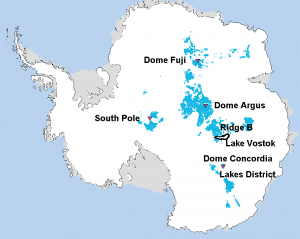
How far into the past can ice-core records go? Scientists have now identified regions in Antarctica they say could store information about Earth’s climate and greenhouse gases extending as far back as 1.5 million years, almost twice as old as the oldest ice core drilled to date. The results are published today in Climate of the Past, an open access journal of the European Geosciences Union (EGU).
By studying the past climate, scientists can understand better how temperature responds to changes in greenhouse-gas concentrations in the atmosphere. This, in turn, allows them to make better predictions about how climate will change in the future.
“Ice cores contain little air bubbles and, thus, represent the only direct archive of the composition of the past atmosphere,” says Hubertus Fischer, an experimental climate physics professor at the University of Bern in Switzerland and lead author of the study. A 3.2-km-long ice core drilled almost a decade ago at Dome Concordia (Dome C) in Antarctica revealed 800,000 years of climate history, showing that greenhouse gases and temperature have mostly moved in lockstep. Now, an international team of scientists wants to know what happened before that.
At the root of their quest is a climate transition that marine-sediment studies reveal happened some 1.2 million years to 900,000 years ago. “The Mid Pleistocene Transition is a most important and enigmatic time interval in the more recent climate history of our planet,” says Fischer. The Earth’s climate naturally varies between times of warming and periods of extreme cooling (ice ages) over thousands of years. Before the transition, the period of variation was about 41 thousand years while afterwards it became 100 thousand years. “The reason for this change is not known.”
Climate scientists suspect greenhouse gases played a role in forcing this transition, but they need to drill into the ice to confirm their suspicions. “The information on greenhouse-gas concentrations at that time can only be gained from an Antarctic ice core covering the last 1.5 million years. Such an ice core does not exist yet, but ice of that age should be in principle hidden in the Antarctic ice sheet.”
As snow falls and settles on the surface of an ice sheet, it is compacted by the weight of new snow falling on top of it and is transformed into solid glacier ice over thousands of years. The weight of the upper layers of the ice sheet causes the deep ice to spread, causing the annual ice layers to become thinner and thinner with depth. This produces very old ice at depths close to the bedrock.
However, drilling deeper to collect a longer ice core does not necessarily mean finding a core that extends further into the past. “If the ice thickness is too high the old ice at the bottom is getting so warm by geothermal heating that it is melted away,” Fischer explains. “This is what happens at Dome C and limits its age to 800,000 years.”
To complicate matters further, horizontal movements of the ice above the bedrock can disturb the bottommost ice, causing its annual layers to mix up.
“To constrain the possible locations where such 1.5 million-year old – and in terms of its layering undisturbed – ice could be found in Antarctica, we compiled the available data on climate and ice conditions in the Antarctic and used a simple ice and heat flow model to locate larger areas where such old ice may exist,” explains co-author Eric Wolff of the British Antarctic Survey, now at the University of Cambridge.
The team concluded that 1.5 million-year old ice should still exist at the bottom of East Antarctica in regions close to the major Domes, the highest points on the ice sheet, and near the South Pole, as described in the new Climate of the Past study. These results confirm those of another study, also recently published in Climate of the Past.
Crucially, they also found that an ice core extending that far into the past should be between 2.4 and 3-km long, shorter than the 800,000-year-old core drilled in the previous expedition.
The next step is to survey the identified drill sites to measure the ice thickness and temperature at the bottom of the ice sheet before selecting a final drill location.
“A deep drilling project in Antarctica could commence within the next 3-5 years,” Fischer states. “This time would also be needed to plan the drilling logistically and create the funding for such an exciting large-scale international research project, which would cost around 50 million Euros.”
Note : The above story is based on materials provided by European Geosciences Union










